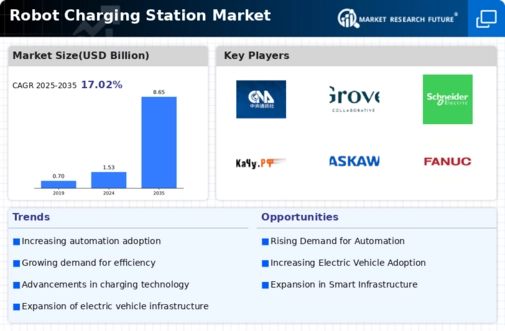Rising Demand for Automation
The increasing demand for automation across various sectors appears to be a primary driver for the Robot Charging Station Market. As industries seek to enhance efficiency and reduce operational costs, the adoption of robotic solutions is on the rise. According to recent data, the market for industrial robots is projected to grow significantly, with a compound annual growth rate of over 10 percent. This surge in automation necessitates a corresponding increase in charging infrastructure, as robots require reliable and efficient charging solutions to maintain productivity. Consequently, the Robot Charging Station Market is likely to experience substantial growth as businesses invest in automated systems and the necessary support infrastructure.
Increased Focus on Sustainability
An increased focus on sustainability is emerging as a significant driver for the Robot Charging Station Market. Companies are increasingly prioritizing eco-friendly practices, leading to a surge in the adoption of electric and automated solutions. The shift towards sustainable operations often necessitates the implementation of charging stations that support electric robots. Market analysis indicates that businesses are investing in green technologies to reduce their carbon footprint, which includes the integration of efficient charging solutions. This trend suggests that the Robot Charging Station Market will benefit from the growing emphasis on sustainability, as organizations seek to align their operations with environmental goals.
Advancements in Battery Technology
Advancements in battery technology are poised to play a crucial role in the Robot Charging Station Market. Innovations such as faster charging capabilities and longer battery life are enhancing the performance of robotic systems. For instance, lithium-ion batteries have become increasingly prevalent due to their efficiency and longevity. As these technologies evolve, the need for compatible charging stations that can accommodate new battery types and charging speeds becomes essential. This trend suggests that the Robot Charging Station Market will expand as manufacturers strive to keep pace with technological advancements, ensuring that charging solutions are both effective and future-proof.
Government Initiatives and Support
Government initiatives aimed at promoting automation and electric mobility are likely to bolster the Robot Charging Station Market. Various governments are implementing policies that encourage the adoption of robotic technologies, particularly in sectors such as manufacturing and logistics. Financial incentives, grants, and subsidies are being offered to businesses that invest in automation, which indirectly supports the growth of charging infrastructure. For example, initiatives to reduce carbon emissions may lead to increased funding for electric vehicle charging stations, which can also serve robots. This supportive regulatory environment indicates a promising outlook for the Robot Charging Station Market as it aligns with broader sustainability goals.
Growth of E-commerce and Logistics
The rapid growth of e-commerce and logistics sectors is significantly influencing the Robot Charging Station Market. As online shopping continues to rise, companies are increasingly relying on automated solutions to streamline operations and meet consumer demands. Robotics plays a vital role in warehousing and distribution, necessitating efficient charging stations to ensure uninterrupted service. Market data suggests that the logistics automation market is expected to reach substantial figures in the coming years, further driving the need for reliable charging infrastructure. This trend indicates that the Robot Charging Station Market will likely expand in tandem with the growth of e-commerce, as businesses seek to optimize their supply chains.
























Leave a Comment